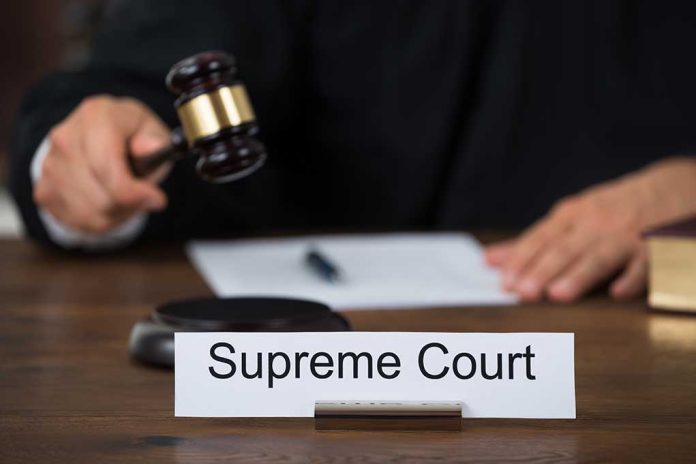
Justice Clarence Thomas lambasted the Supreme Court for refusing to protect Americans’ Second Amendment rights, declaring he “would not wait to decide whether the government can ban the most popular rifle in America.”
Key Takeaways
- The Supreme Court declined to review Maryland’s ban on AR-15 rifles, with Justice Thomas issuing a forceful dissent defending Second Amendment rights.
- Thomas, joined by Justices Alito and Gorsuch, argued that AR-15s meet the “common use” standard with 20-30 million owned by Americans, making them constitutionally protected.
- Justice Brett Kavanaugh indicated the Court will likely address the AR-15 issue “in the next Term or two,” while noting these firearms are legal in 41 states.
- The Court’s decision allows Maryland’s ban to remain in effect, continuing what conservatives view as an infringement on constitutional rights.
- Thomas warned that without Court intervention, AR-15 owners must rely on federal agencies’ discretion rather than constitutional guarantees.
Thomas Leads Dissent Against Court’s Refusal to Hear AR-15 Case
Justice Clarence Thomas has delivered a scathing rebuke of the Supreme Court’s decision not to hear a challenge to Maryland’s ban on AR-15 rifles, highlighting a crucial battle over Second Amendment rights. The case, David Snopes, et al. v. Anthony G. Brown, questioned whether states can legally prohibit America’s most popular rifle when millions of law-abiding citizens own them. Thomas, along with Justices Samuel Alito and Neil Gorsuch, strongly advocated for the Court to take up the case immediately, rather than continuing to avoid this constitutional question that has remained unaddressed for a decade.
The Fourth Circuit Court of Appeals previously upheld Maryland’s ban, ruling that AR-15s are not protected “arms” under the Second Amendment. This decision directly conflicts with the Supreme Court’s landmark Heller decision, which established that weapons in “common use” are constitutionally protected. Thomas highlighted this contradiction, arguing that with tens of millions of Americans owning AR-15s for lawful purposes including self-defense, these firearms clearly meet the “common use” standard and deserve constitutional protection against government prohibition.
“I would not wait to decide whether the government can ban the most popular rifle in America. That question is of critical importance to tens of millions of law-abiding AR–15 owners throughout the country. We have avoided deciding it for a full decade,” Said Justice Clarence Thomas, Associate Justice of the Supreme Court.
Kavanaugh Signals Future Supreme Court Action
While joining the majority in declining to hear the case now, Justice Brett Kavanaugh indicated that the Supreme Court would likely address the AR-15 issue soon. His statements suggest that the Court recognizes the constitutional significance of the question but is waiting for additional circuit court rulings to provide more legal context. Kavanaugh specifically noted that the Fourth Circuit’s reasoning appeared “questionable” under Supreme Court precedents, particularly given the widespread ownership and legal status of AR-15s across the nation.
“This case primarily concerns Maryland’s ban on the AR–15, a semi-automatic rifle. Americans today possess an estimated 20 to 30 million AR–15s. And AR–15s are legal in 41 of the 50 States, meaning that the States such as Maryland that prohibit AR–15s are something of an outlier. Given that millions of Americans own AR–15s and that a significant majority of the States allow possession of those rifles, petitioners have a strong argument that AR–15s are in ‘common use’ by law-abiding citizens and therefore are protected by the Second Amendment under Heller,” Said Justice Brett Kavanaugh, Associate Justice of the Supreme Court.
Kavanaugh specifically stated, “In my view, this Court should and presumably will address the AR–15 issue soon, in the next Term or two.” This timing suggestion may offer some hope to Second Amendment advocates, though the delay continues to leave AR-15 owners in Maryland and other restrictive states without constitutional protection for their firearms. The Court’s reluctance likely stems from uncertainty about how Justices Amy Coney Barrett and Chief Justice John Roberts might rule on this contentious issue.
Constitutional Concerns and Practical Implications
Thomas’s dissent highlighted another crucial concern for gun rights advocates: the potential for federal agencies to reclassify AR-15s as machineguns, which would subject them to additional restrictions or even prohibition. Without clear Supreme Court guidance establishing AR-15s as protected arms under the Second Amendment, owners must rely on the discretion of federal agencies rather than constitutional guarantees. This regulatory uncertainty represents a significant vulnerability for gun owners that Thomas argued should be addressed immediately.
“AR–15s appear to fit neatly within that category of protected arms. Tens of millions of Americans own AR–15s, and the ‘overwhelming majority’ of them do so for lawful purposes, including self-defense and target shooting,'” Stated Clarence Thomas.
The Fourth Circuit’s decision to uphold Maryland’s ban relied on characterizing AR-15s as “dangerous and unusual” weapons, despite their common ownership and legal status in most states. Thomas criticized this reasoning as placing an inappropriately high burden on Second Amendment challengers and inverting the constitutional analysis required by the Court’s precedents. By refusing to hear this case, the Supreme Court has allowed a decision to stand that many conservatives view as a direct assault on Americans’ fundamental right to keep and bear arms.
A Pattern of Second Amendment Avoidance
Thomas’s pointed criticism that the Court has “avoided deciding” this critical constitutional question “for a full decade” highlight what many gun rights advocates see as a troubling pattern of the Court declining to fully defend Second Amendment rights. The decision to deny review allows Maryland’s ban to remain in effect and permits other states to continue implementing similar restrictions without clear constitutional boundaries. For millions of law-abiding AR-15 owners, this represents a concerning erosion of their constitutionally protected rights through legislative action without judicial protection.
While the Court has declined to address this issue now, the strong dissent from Thomas and indications from Kavanaugh suggest that a definitive ruling on whether the government can ban AR-15s may come within the next few Supreme Court terms. Until then, the constitutional status of America’s most popular rifle remains in a precarious position, dependent on state legislatures and lower courts that have often been hostile to Second Amendment rights. The outcome of this eventual decision will have profound implications for gun owners nationwide.







